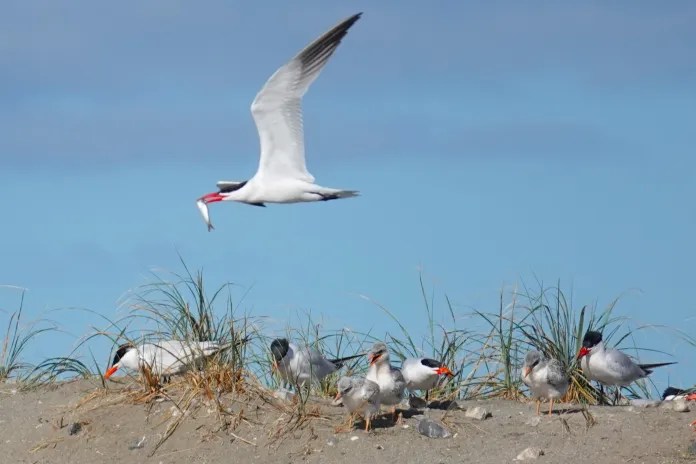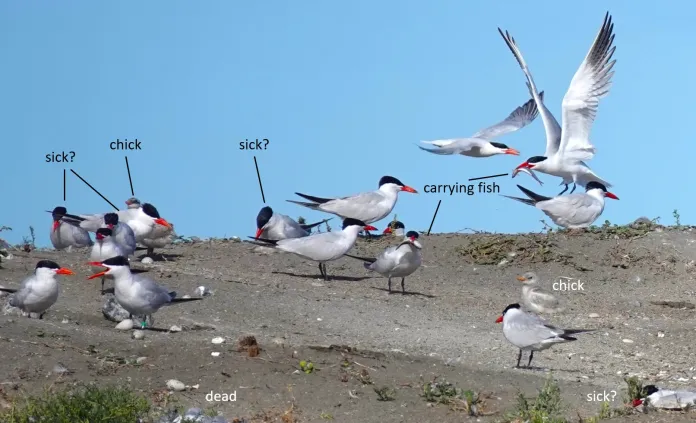The Caspian Tern colony, the one across the bay from the Port Townsend waterfront, was just wiped out by avian flu. Nearly. An overflight by the Washington Department of Fish and Wildlife (WDFW) estimated the colony at 1,800 adults. Over the summer, after many visits to the island, their staff picked up 1,131 dead adults and 514 dead chicks. Many more were probably never found.
These are the sports car version of a gull, with black caps and red bills. They dive for fish in front of ferry boats and call as if they are pterodactyls. Their decimation by avian flu is painful on several levels.
First, this colony, on Rat Island just off the tip of the spit at Fort Flagler Campground, is a relatively new phenomenon. Analysis of satellite images suggest it began last year. Unfortunately, in 2022, in two attempts, about a thousand adults produced maybe a dozen fledglings. The first attempt was wiped out by human disturbance. A minus-four tide on the Fourth of July enticed many campers to walk from the spit to the island. I personally watched through my scope as a couple with a dog (on a leash) walked right up to the colony, putting all the birds up in the air, and stood there, naively enjoying the birds and filming them with their phones. Unbeknownst to them, gulls were pouring in underneath the cacophonous mob of terns, no doubt devouring eggs and chicks. This is how human disturbance impacts seabird colonies.
A month later, the gulls tried again. This time a coyote managed to swim across from Indian Island and had a feast. Coyotes previously wiped out a colony on the tip of Dungeness Spit.

This year we were prepared to at least address the human disturbance problem. As the Conservation Chair of Admiralty Audubon, I reached out to State Parks and WDFW. They contacted the Friends of Fort Flagler, who created a team of 25 volunteers to serve as docents during extreme low tides to intercept and educate beachgoers about the terns – and the harbor seal haul-out next to it. WDFW put up signs around the island to educate kayakers, and State Parks did the same at Flagler.
Everyone was trained and more birds than ever came to nest. They seemed to be doing great. Most were on eggs, and we estimated they were just about to hatch. Then, on July 10, Sam Kaviar, a naturalist guide who runs Olympic Kayak Tours, noticed a dead tern. Not a big deal, I told him, unless you start seeing more. Within two hours, he saw a dozen more. He called WDFW. They were nearby in a boat so came over to check it out. They collected 35 dead terns and suspected highly pathogenic avian influenza (HPAI), caused by the H5N1 virus. They collected carcasses to run tests, which eventually came back positive.

The second painful thing is that Caspian Terns are a relatively long-lived slow-reproducing species. The loss of chicks is one thing, but the loss of adults is a much bigger deal. Caspian Terns, the largest tern in the world, can live 26 years. Most adults live 10 to 15 years. This means they only need to reproduce themselves once every 15 years or so to sustain their population. It also means that, if you lose an adult, it might take many years to replace them.
The third painful thing is that Caspian Terns are already declining, both in the Pacific Northwest, up and down the entire West Coast, and across the whole continent. The Birds of the World species account for Caspian Tern, in the section on conservation concerns, highlights their need for disturbance-free nesting sites, “Human disturbance at colonies facilitates egg predation by gulls when more wary terns are flushed from nests.”

The fourth painful thing is that Caspian Terns were deliberately pushed off from most of their other breeding sites in the Pacific Northwest in the past 15 years. They do not nest scattered across the landscape like robins or even gulls. Like many seabirds, they nest in tight colonies, packed together, one nest every few feet. In the Pacific Northwest, enormous colonies were hazed off Sand Island in the Columbia River delta by government agencies because they were eating too many salmon smolts – which are endangered because of the dams. (Note, photos of prey items at Rat Island have shown the terns eating candlefish, herring, smelt, surf perch, and juvenile salmon – the latter only toward the end of their nesting period.)
Many relocated to rooftops in Seattle or to empty lots in Bellingham. In recent years, they have been hazed off there too. That is exactly why the Rat Island colony near Port Townsend grew so suddenly. It is a colony of refugees. We have photographed birds there that were banded at Sand Island, in Bellingham, even from the Tri-Cities area. This spring, as the colony was forming, local experts concluded that this was the only Caspian Tern colony in the Salish Sea. Now 80% of them are dead.

Like Covid, HPAI has recently become part of our world. While the virus has long had a reservoir in waterfowl and shorebirds, where it was usually asymptomatic, it has been a deadly plague to domestic poultry for decades. In 1996, it mutated and spread back into wild birds with lethal affect. In the summer of 2021, it began impacting wild bird nesting colonies across Asia, Europe, and Africa.
This deadly strain arrived in North America in the fall of 2021. The United Nations issued a concise report in July 2023. They open with this: “H5N1 high pathogenicity avian influenza (HPAI) is currently causing unparalleled mortality of wild birds and mammals worldwide…” They described it as unprecedented based on the scale of mortality (often approaching 90%) and geographic spread (nearly worldwide).
In Washington, it has percolated since 2014, mostly impacting domestic poultry. The first significant impact to wild birds occurred last winter in waterfowl (mostly Snow Geese) in the Skagit Flats.
This summer’s outbreak at the tern colony was the first known incidence of HPAI in a wild bird breeding colony in Washington. A smaller outbreak killed about 500 Caspian Terns at the Columbia River delta. Consistent with experience in Europe, it impacted the gulls less, as they nest further apart from each other. WDFW staff collected 24 adult and 248 chick “Olympic Gulls” (Western x Glaucous-winged Gull hybrids). Bald Eagles and Black Oystercatchers are also present near the colony and potentially vulnerable, though no dead birds of these species have been found.
The largest seabird colony in the region is at Protection Island, with over 10,000 Rhinoceros Auklets. That is only nine miles away as the tern flies. While these terns forage up to 30 miles from their colony, and auklets forage near Rat Island, there has been no evidence of transmission.
The virus has spread to Harbor Seals, which haul out a stone’s throw from the tern colony. To date, avian flu has been confirmed in three dead adults. Transmission from birds to seals has also occurred on the East Coast and in Europe. Fears that it would spread to dogs – or humans – at Fort Flagler did not materialize. Cases in humans are rare, but potentially deadly.

Hope remains. On my last visit to the island (staying offshore in a kayak), on August 11, there were still approximately 350 adults. Some were flying into the colony carrying fish. On the beach, I could see about a dozen chicks of varying ages, adults offering them fish, as well as a few dead adults and others that appeared sick. I am hopeful that over 20% of the adults will survive. That sounds pathetic, but it’s a start.
Data from Europe suggests they may acquire immunity. And, despite the carnage, it looks like this colony may actually produce more fledges than last year. So that’s another start. The terns have since left the colony – and the region – heading south to California and Mexico for the winter. We will be ready for them next year as they begin their long road to recovery.
An earlier version of this article was published by Admiralty Audubon and by Rainshadow Journal.
Discover more from Post Alley
Subscribe to get the latest posts sent to your email.

Thank you for this insightful, if heartbreaking story on the staggering decline of this beautiful, showy bird. The avian flu is bad enough — but it’s disturbing to read about how even one pair of humans with a dog can have a devastating effect on vulnerable bird populations.
At least, the dog was on a leash–too often I see them permitted to run unchecked on Washington beaches, chasing ducks and geese and other water fowl, watched benignly by humans.
I am puzzled at the deliberate hazing of the colonies by government agencies — on a bird that is in marked decline.
Glad, too, that the terns might have a chance at acquiring immunity from that deadly disease.